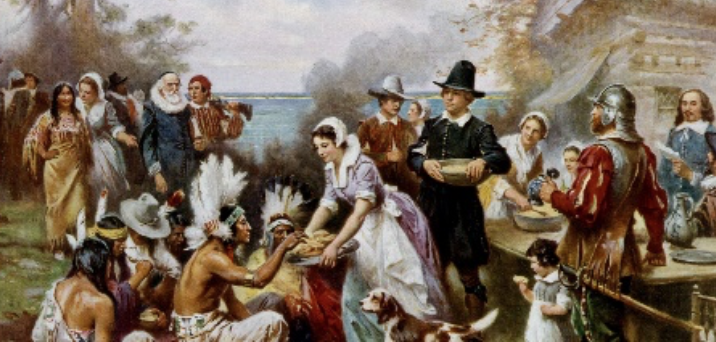GUEST WORDS--Each year we celebrate Thanksgiving on the fourth Thursday of November — we eat turkey, cranberry sauce and mashed potatoes to commemorate the 1621 feast at which Pilgrims and Wampanoags peacefully gathered in Plymouth, Massachusetts.
And every year since, Americans have put aside their own family feuds and followed strict traditions to show their appreciation for everything they have. At least that’s the narrative most of us have been taught.
But as it turns out, Thanksgiving might not actually be as rich in objective historical context and deep-rooted traditions as we’d like to believe.
For starters, the 1621 harvest celebration between Pilgrims and Wampanoags in Plymouth is generally thought of as the first Thanksgiving. But Virginia, Texas and Florida all claim they hold the same title for various feasts held at earlier times within their states.
And it wasn’t until 1789 when George Washington declared Thursday, Nov. 26, a day of “PUBLIC THANKSGIVING and PRAYER … to the service of that great and glorious Being, who is the beneficent Author of all the good that was, that is, or that will be.”
After Washington’s declaration, presidential proclamations would announce Thanksgiving on different days and months each year. Thanksgiving hasn’t been a continual tradition since its inception nearly four centuries ago, and was not perpetuated as the more secularized holiday we know it to be today.
But regardless of time and place of origin, there’s no question Thanksgiving is distinctly and traditionally American, right? Actually, Canada, Germany, Japan, Grenada, Liberia and many other countries all have their own variants of Thanksgiving with histories dating back much further than our own.
And even here in the United States, different cultural communities incorporate their own traditions into the celebration. Tom Carabuena, junior communication science and disorders major, celebrates his heritage by eating deep fried turkey alongside traditional Filipino dishes like mechado, beefsteak and pancit.
“I like that there’s a mix of things because we still have a more traditional Thanksgiving meal, but we’re also able to share our culture and enjoy our own food,” Carabuena said. “So we really get the best of both worlds.”
But how traditional are those foods to begin with? That oven-baked pumpkin pie and perfectly roasted turkey the Pilgrims and Wampanoags famously feasted on way back in 1621? Unfortunately, this too is an eye-opening myth of Thanksgivings past. It was during the mid-1800s that a woman named Sarah Josepha Hale created many of the “traditional” recipes we know today.
Hale, an influential 19th-century author, education advocate and editor of the magazine Godey’s Lady’s Book, became widely known for publishing the latest in literature, fashion and cooking trends. But Hale was also a history buff and, after reading about the 1621 feast, became the country’s first and leading champion for turning Thanksgiving into a national holiday.
She published recipes for turkey, stuffing and pumpkin pie, modified from foods she believed may have been present around the time of the first feast. While there may have been cranberries and pumpkins, it’s unlikely that either were cooked down and mashed. And turkey is never actually mentioned in firsthand accounts of the harvest fest, but fowl and venison are. So Hale’s annual editorial urging Thanksgiving’s inauguration as a national holiday was actually the start of many food traditions we know today.
Along with her editorials, Hale began a campaign encouraging people to write letters addressing the president, as well as all members of Congress and governors of U.S. states and territories, in the hope of establishing Thanksgiving as an official national holiday.
Still, it wasn’t until Lincoln’s Proclamation of Thanksgiving in 1863 that the holiday gained national status and the last Thursday of each November became a tradition, though not a set date.
But during Franklin Roosevelt’s presidency in 1933, its date began to split the nation. Business leaders argued that if the holiday was held on the last Thursday of the month, just 24 days between Thanksgiving and Christmas wouldn’t leave enough time for holiday shopping. They asked Roosevelt to move the holiday up one week with the goal of stimulating the economy during the Great Depression.
Roosevelt refused, but when the same concern arose again in 1939, he conceded and declared that Thanksgiving would be held Nov. 23. However, in favor of tradition, many states chose to continue celebrating the holiday one week later, Nov. 30.
Roosevelt would hold Thanksgiving on the second to last Thursday of the month for two more years. But this divide meant that families in different states were often unable to celebrate together. Public outcry grew so strong that Congress passed a law Dec. 26, 1941, declaring Thanksgiving a set date to be celebrated on the fourth Thursday of November each year.
Over the years, Thanksgiving has slowly been built up to the holiday we recognize today. The truth is, Thanksgiving has grown from so many invented traditions, many of us remain misinformed about its origins. But while we may blur the line between those traditions and their realities, the principles of gratitude and togetherness the holiday has always been rooted in remain clear.
(Jaime Viens is a Contributing Editor at Pitt News. This Thanksgiving column was published last year by Pitt News.)
-cw






